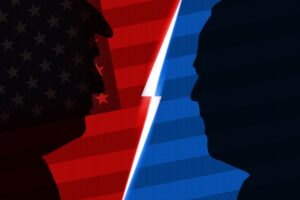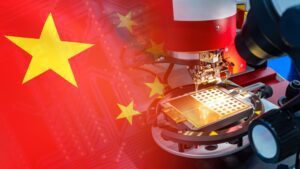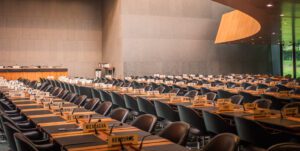Bidenomics Versus Maganomics on Trade Law: Pick Your Poison
|
Next Wednesday, April 17, WITA will host a webinar titled “Biden 2.0 or Trump 2.0? What We Might Expect on Trade Policy in a Second Term” Information can be found here and below. Following are excerpts from a policy brief published by the Institute for European Policymaking at Bocconi University. On January 20, 2025, someone will take the oath of office to serve as President for the next four years. A rematch seems to loom between Joseph Biden and Donald Trump. More than the names of the candidates will be on the ballot. Voters will choose the future role of the United States in the world. Voters will also choose the economy they will live with for the next four years and beyond… Donald Trump’s “Maganomics” Donald Trump on the campaign trail today still preaches the populist idea that tariffs benefit domestic industries and produce jobs and produce billions in revenue for the federal government. Trump has never been deterred by the opinions of economists who say that tariffs are taxes on American consumers and producers. Trump, the self-described “tariff man,” plans to double down on tariffs if he wins a second term as president. First, he intends to impose a new “universal baseline tariff” of 10 percent on all imports into the United States. Second, he is considering two possible options with regard to new tariffs on China. One option is to revoke China’s “most favored nation” status for trade with the United States. This would immediately result in huge tariffs on all Chinese products. If this option is problematic — it is against the rules of the WTO — Trump intends to simply impose across the board tariffs of 60 percent on all Chinese products. The magnitude of these proposed tariffs on Chinese products appears to mean that Trump will seriously aim to decouple the U.S. and Chinese economies… Joseph Biden’s “Bidenomics” The Biden administration’s trade policy prioritizes labor and the American worker over consumerism. Biden’s 2021 Report to Congress states that American workers should be at the forefront of trade policy. Trade must be conducted to benefit regular American communities and workers. Trade policy must recognize that people are not just consumers, they are workers and wage-earners. Trade policy must protect American jobs not just low prices for consumers. A threshold decision for the Biden administration was whether to repeal the Trump tariffs. At the time inflation was high. Numerous commentators advised Biden to rescind the Trump tariffs, arguing this action would lower U.S. inflation by 1 to 2 percent. Biden rejected this advice; he chose to defend the Trump tariffs in court litigation. Biden’s defense was successful. Biden did, however, allow importers to seek exclusions on grounds such as lack of domestic supply. The Biden administration also vigorously defended the section 301 tariffs on China and ultimately prevailed in court. The Biden administration has not sought to lift these tariffs either unilaterally or in conjunction with an agreement with China. |
|
Whole-of-Nation Innovation:Does China’s Socialist System Give It an Edge in Science and Technology?
The topic of China’s ambitions in science and technology will be discussed at the WITA Academy’s China Virtual Intensive Trade Seminar on May 9-10. Information can be found here and below.
On October 17, 2023, the United States issued its second batch of export controls on advanced computing and semiconductor manufacturing items to China, expanding its “small yard, high fence” approach to include more technologies and impact more countries. The European Commission has similar concerns about technology leakage but is more circumspect in its response. Its economic security strategy calls for partnering with allies, promoting competitiveness, and protecting interests “in a proportionate and precise way that limits any negative unintended spillover effects on the European and global economy.” The Commission intends to complete a security review of four critical technologies in 2024.
China is a major catalyst of the global trend of scientific and technological nationalism, with its party and state leader Xi Jinping doubling down on national security ever since he came to power in 2012. For instance, in 2016 Xi called for national self-reliance and self-empowerment in key and core digital technologies at the inaugural Work Conference for Cybersecurity and Informatization, predating U.S. sanctions by several years. Science, technology, and innovation (STI) have become the main arena of global strategic competition, Xi announced in 2022, adding that the contest over the scientific and technological commanding heights of the global economy has never been more intense.
Diverse geopolitical actors across the United States, European Union, and China have different interests, priorities, and approaches in securing key technologies. But the net result is that science, technology, and innovation have become increasingly political. Policy is now driven by national security concerns, which creates friction in international networks. Joint publications between U.S. and Chinese researchers are already declining.
Chinese and Western firms face questions about their loyalty at home and abroad, as well as complex regulations for exporting data and goods involving strategic or critical technologies.
To understand this trend, this brief offers a thorough analysis of Beijing’s vision for its innovation and industrial systems based on close readings of high-level policy documents and commentaries.
Collectivizing Industrial Efforts
The Communist Party of China has a long history of directing industrial development, combining domestic goals of providing basic goods, jobs, and economic growth with notions of self-reliance and national security that emphasize international competition. The notion of the “new-style whole-of-nation” system (NSWN) takes inspiration from this history. It has gained prominence since the fourth plenum of the 19th Central Committee in 2019 as Beijing seeks to capitalize on the socialist system’s unique ability to “concentrate power to do great things.” The 14th Five-Year Plan of 2021-2025 presented the NWNS system as a key component of “the battle for key and core technologies.”
|
Economic Multilateralism 80 Years After Bretton Woods
Excerpts from a working paper published by the Peterson Institute for International Economics.
Eighty years ago, negotiators from 44 countries meeting at Bretton Woods, New Hampshire, devised multilateral institutions and rules that they hoped would steer the postwar world economy toward durable peace and prosperity. A key feature of the Bretton Woods rules was a global system of fixed but adjustable dollar exchange rate parities, which the advanced economies abandoned in 1973 after nearly three decades. In many ways, 1973 was a key moment in the transition from the post-World War II world economy to the modern world economy, far beyond the seemingly technical issue of the exchange rate regime. Contrary to forecasts that more variable exchange rates would fragment the international system, as during the period between the world wars, the decades after 1973 saw the world economy reach an unprecedented degree of economic integration. Economic multilateralism adapted and in some respects grew stronger.
Today, a new chapter may have opened. In the wake of financial crises unprecedented since the Great Depression, persistent economic inequality, migratory pressures on Europe and the United States intensifying in the mid-2010s, Brexit, the norm-breaking U.S. Trump administration of 2017-21, the first global pandemic in a century, an accelerating climate crisis, the Russian invasion of Ukraine, and the newest Israel-Gaza war, the world looks to have moved into a distinct era echoing many of the interwar tensions that the post-World War II settlement sought to overcome. And unlike in the 1920s and 1930s when radio first became widely available, modern media display global stresses to everyone visually and in real time and amplify them in a way undreamed of then. How much reversion toward the troubled past is likely, and to what extent will that reversion undermine the global community’s ability to address common challenges, some inconceivable before World War II?
As an economist, I will focus mainly on issues related to commerce and finance, but the nature of the current malaise underscores the inherent inseparability of geopolitics, domestic politics, and economics. The destabilizing potential of this interplay was less salient for parts of the postwar period, especially in the quarter-century or so from the collapse of the Soviet bloc over 1989-91 to the mid-2010s. After that brief belle époque, however, history has indeed returned, with a vengeance.
…The current global landscape, dominated by geopolitical and economic tensions between the United States and China, threatens to undermine coordinated action on common threats—including climate change, pandemics, cyber risks, economic instability, and nuclear proliferation. It may also weaken the precious institutional architecture of international cooperation that was fortuitously established in unique historical circumstances at the end of World War II.
In its drive to contest U.S. dominance, China is promoting its own vision and leadership aspirations for middle- and lower-income countries, backed up by economic diplomacy and sponsorship of alternative international institutions. Unlike during the Cold War rift between the Americans and the Soviets, however, China’s economic interdependency with high-income U.S.-aligned countries is extensive, raising the costs of conflict for both sides but also creating shared incentives for more cooperative solutions. And, it must be said, almost all other countries, whether in the West or elsewhere, would welcome a pivot from conflict to more constructive competition.
|
Why Have Developing Countries Soured on Multilateralism?
|
Multilateralism is waning, and one of the world’s leading multilateral institutions, the World Trade Organization, is in crisis, because the United States has been blocking new appointments to its dispute settlement mechanism’s Appellate Body since 2018. In the run-up to the WTO’s 13th Ministerial Conference last month, some optimists hoped to see progress on specific issues, such as an agreement not to impose tariffs on digital commerce, but expectations were generally low. The pessimists were right. India led the charge against extending a moratorium on e-commerce tariffs, and only a last-minute deal prolonged it for another two years. After that, it is expected to expire. India and its allies celebrated the outcome as a victory. For the first time in years, the culprit undermining the WTO was not the US but developing countries (including Indonesia, South Africa, Brazil, and others). True, what happened with digital commerce is characteristic of the usual conflicts that play out during trade negotiations. Free trade always produces winners and losers. Digital commerce may be in the interest of businesses in advanced economies as well as consumers and businesses in low- and middle-income countries; users of an app, game, or other software product made in a different country may pay lower prices in the absence of tariffs. But domestic producers will reliably demand protection from imports, and governments will see tariffs as a promising way to boost revenues. While these issues are typical, developing countries’ opposition to an extended digital-tax moratorium is emblematic of a deeper problem: namely, the growing impression that the WTO has nothing to offer them anymore. The assumption is that it unilaterally serves the interests of big businesses rather than of the average person in a low- or middle-income country. But is this true? In fact, recent research shows that poverty reduction in the past three decades has been more likely in developing countries that are well integrated into the international trade system – as measured by the number of signed trade agreements and access to large, lucrative export markets. In this sense, the multilateral trade system has indeed benefited the developing world. |
|
|
|
WITA – We put the community in trade community.Information about upcoming WITA and trade community events TRADE COMMUNITY EVENTS CALENDAR |





